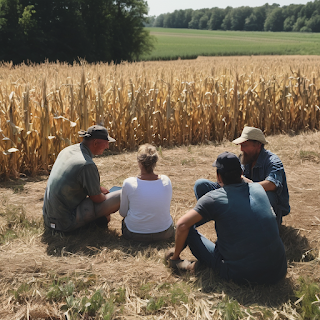The future of agriculture is sustainable. As a young farmer concerned about both the environment and my bottom line, I'm always on the lookout for innovative practices that can help me grow high-quality crops while protecting precious natural resources. One approach showing great promise is AESA, or Agro Eco-System Analysis.
AESA takes a holistic view of the farm as a living ecosystem, assessing soil health, water use, biodiversity, and more. Rather than relying on chemical inputs, it aims to foster beneficial interactions between all components of the agroecosystem to achieve natural pest and disease control. Proper AESA implementation leads to resource-use efficiency and climate resilience over the long run.
As a new generation farmer, sustainability is my top priority. I want future generations to inherit fertile soil and clean water just as I have. But going chemical-free isn't easy or straightforward. That's why I'm excited about projects like the AESA Farming Academy by Gro Intelligence. Their online courses and field guides provide a step-by-step process for transitioning to this approach.
Getting Started with AESA
Embarking on the AESA Journey
To commence my journey into Agroecological System Analysis (AESA), I decided to enroll in Gro Intelligence's foundational course. The course provided a comprehensive introduction to AESA principles and practices, offering valuable insights into sustainable agriculture.
Mapping Farm Resources
The first key step in AESA involves conducting a whole-farm resource mapping. This process aims to understand the assets and limitations of the farm, encompassing factors such as soil type, water sources, and biodiversity hotspots. This initial assessment lays the foundation for informed decision-making.
Community Engagement through Participatory Rural Appraisal
AESA emphasizes the importance of local ecological knowledge. Through participatory rural appraisal, farm workers, families, and community members actively contribute their insights. This collaborative approach enriches the understanding of the agroecosystem, incorporating traditional wisdom into modern agricultural practices.
Continuous Observation with Weekly Farm Walks
Regular farm walks and observations form a crucial aspect of AESA. By recording fluctuations in soil moisture and monitoring pest/disease prevalence over time, farmers develop a dynamic understanding of agroecosystem dynamics. This continuous observation allows for proactive management strategies.
Implementing Monitoring Tools for Precision Agriculture
Simple yet effective monitoring tools, such as pheromone traps and sticky cards, play a significant role in AESA. These tools help track beneficial and harmful insect populations, contributing to precision agriculture practices that focus on ecological balance.
Soil Health Enhancement through Organic Practices
AESA encourages the regular application of organic matter to nourish the soil microbiome. Options like vermicompost, mulching, and green manuring are not only environmentally friendly but also economically viable for farmers, promoting sustainable soil health.
Diversification for Resilience
Planting a diverse range of crops and varieties suited to local conditions is a cornerstone of AESA. This practice increases habitat availability, fostering biodiversity and reducing vulnerabilities to pests and diseases. It enhances the overall resilience of the agroecosystem.
Natural Controls over Synthetic Chemicals
AESA promotes a shift towards biological and cultural controls over synthetic chemicals. By encouraging natural enemies through on-farm biodiversity and habitat manipulation, farmers can establish a more balanced and resilient agroecosystem.
Documentation for Informed Decision-Making
Keeping detailed records using AESA monitoring forms is essential. This documentation helps identify strengths to build on and highlights areas that require attention. It forms the basis for informed decision-making and continuous improvement in farming practices.
In conclusion, the initial steps in the AESA journey have provided a profound understanding of agroecosystems. This approach demands patience, keen observation, and a willingness to experiment. However, the transition to AESA promises more sustainable and climate-resilient farms, marking a transformative shift in agricultural practices.
Moving Towards a Sustainable Food System
As more young farmers like myself adopt AESA practices, I believe we can collectively move global agriculture towards a more sustainable model. Companies developing digital tools and online resources for AESA are making the transition easier for all. For example, Gro Intelligence provides affordable access to expertise through their Academy that would otherwise be inaccessible to smallholder farmers. Their pioneering work in this space deserves recognition.
In conclusion,
AESA shows incredible promise as a holistic, low-external input approach optimized for diverse, small-scale agriculture worldwide. With continued research and farmer-focused programs, it could revolutionize how we view and operate within agroecosystems. I'm excited to continue refining my skills through the AESA Farming Academy and applying what I learn on my own fields. There is still so much more for me to discover! Thank you for reading, and I hope to share more of my sustainable farming journey.

Post a Comment